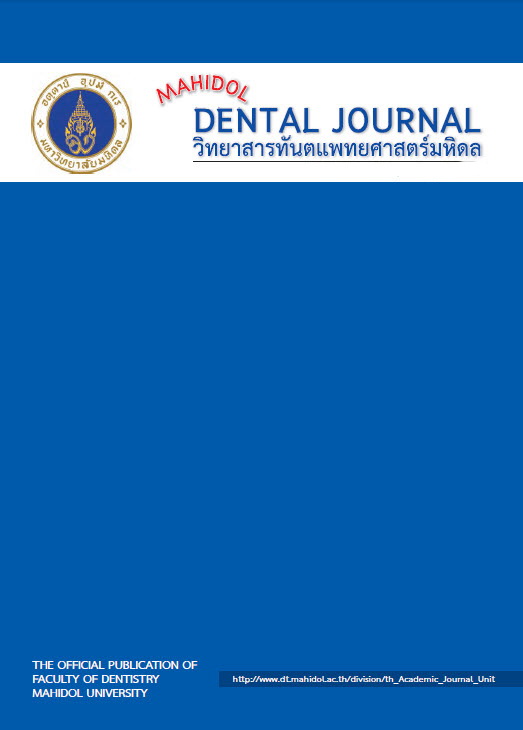Effect of resin volume fraction on fracture toughness of resin-infiltrated ceramic.
Main Article Content
Abstract
Objective: The objective of this study was to investigate effect of resin volume fraction on fracture toughness of resin-infiltrated ceramic (IPS e-max® Ceram).
Materials and Methods: Forty bar specimens (2x4x24 mm) were divided into 4 groups. The control group was IPS e-max® Ceram specimens. They were prepared following the manufacturer’s recommendation. The other groups were IPS e-max® Ceram infiltrated with 0.5%, 1% and 2% by volume of Silane/UDMA/TEGDMA resin mixture. They were prepared by mixing IPS e-max® Ceram glass powder with polymeric fiber (0.5%, 1% and 2 % by volume) until homogenous and added liquid to form slurry. Then, the mixture was packed into the mold and fired according to the firing schedule without vacuum. After that, resin mixture was infiltrated into the specimens under vacuum at 0.01 MPa for 2 hours then cured by dry heat in the oven at 100°C for 6 hours. Vickers hardness tester was used to create pre-crack indentation on the specimen. Four-point bending test was performed using a universal testing machine with a crosshead speed of 0.5 mm/min until fracture. Fracture surfaces of all specimens were examined under optical light microscope. Critical flaw sizes were measured using the fractographic approach, and fracture toughness (KIc) was calculated. One-way ANOVA was used to determine and analyze a significant difference of the mean KIc between control group and 0.5%, 1% and 2% by volume of resin-infiltrated ceramic groups at α = 0.05.
Results: The mean fracture toughness of control group, 0.5%, 1% and 2 % of resin-infiltrated ceramic were 0.69±0.05, 0.71±0.08, 0.77±0.11 and 0.80±0.11 MPa·m1/2 respectively. Only 2 % resin-infiltrated ceramic specimen showed the significant increasing on fracture toughness comparing with the control group, (p < 0.05).
Conclusions: The amount of resin volume fraction of resin infiltrated ceramic had an influence on its fracture toughness.
Article Details
References
2. Conrad HJ, Seong WJ, Pesun IJ. Current ceramic materials and systems with clinical recommendations: a systematic review. J Prosthet Dent 2007; 98: 389-404.
3. Della Bona A, Kelly JR. The clinical success of all-ceramic restorations. J Am Dent Assoc 2008; 139: S8-13.
4. Scherrer SS, Denry IL, Wiskott HW. Comparison of three fracture toughness testing techniques using a dental glass and a dental ceramic. Dent Mater 1998; 14: 246-55.
5. Taira M, Nomura Y, Wakasa K, Yamaki M, Matsui A. Studies on fracture toughness of dental ceramics. J Oral Rehabil 1990; 17: 551-63.
6. Asmussen E, Peutzfeldt A. Influence of UEDMA BisGMA and TEGDMA on selected mechanical properties of experimental resin composites. Dent Mater 1998;14: 51-6.
7. Barszczewska-Rybarek IM. Structure-property relationships in dimethacrylate networks based on Bis-GMA, UDMA and TEGDMA. Dent Mater. 2009; 25: 1082-9.
8. Xu HH. Dental composite resins containing silica-fused ceramic single-crystalline whiskers with various filler levels. J Dent Res 1999; 78: 1304-11.
9. Xu HH. Whisker-reinforced heat-cured dental resin composites: effects of filler level and heat-cure temperature and time. J Dent Res 2000; 79: 1392-7.
10. Chaiyabutr Y, Giordano R, Pober R. The effect of different powder particle size on mechanical properties of sintered alumina, resin- and glass-infused alumina. J Biomed Mater Res B Appl Biomater 2009; 88: 502-8.
11. Coldea A, Swain MV, Thiel N. Mechanical properties of polymer-infiltrated-ceramic-network materials. Dental Mater 2013; 29: 419-26.
12 He LH, Swain M. A novel polymer infiltrated ceramic dental material. Dent Mater 2011; 27: 527-34.
13. Urapepon S, Wiriyapak D, Effect of resin infusion on fracture toughness of dental ceramic. Mahidol Dent J 2017; 37: 1-6.
14. Clarke DR. Interpenetrating Phase Composites. j Am Ceram Soc 1992; 75: 739-59.


